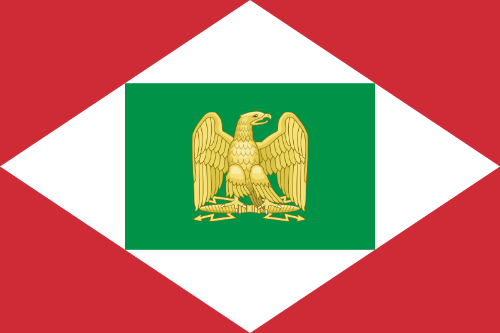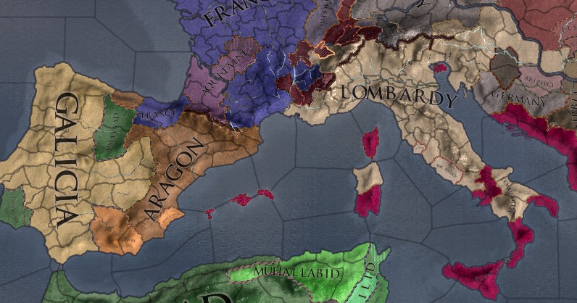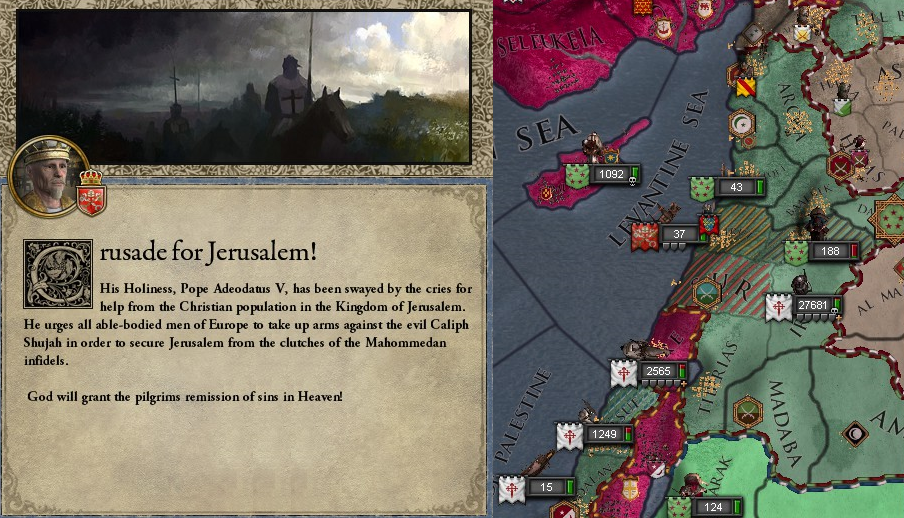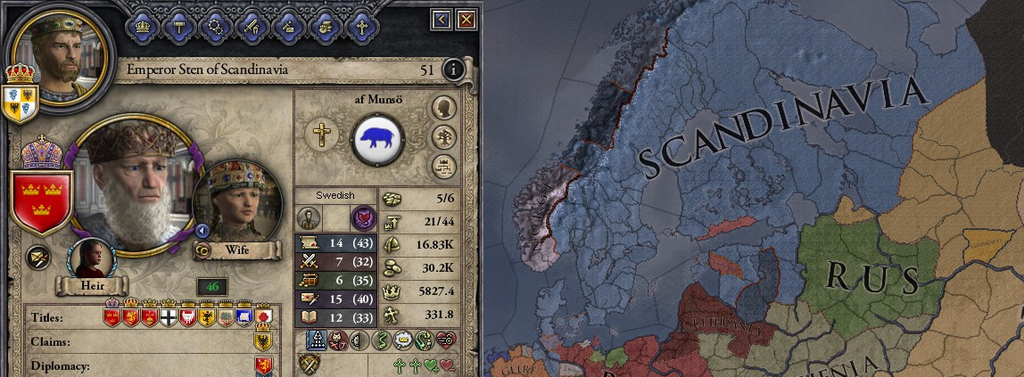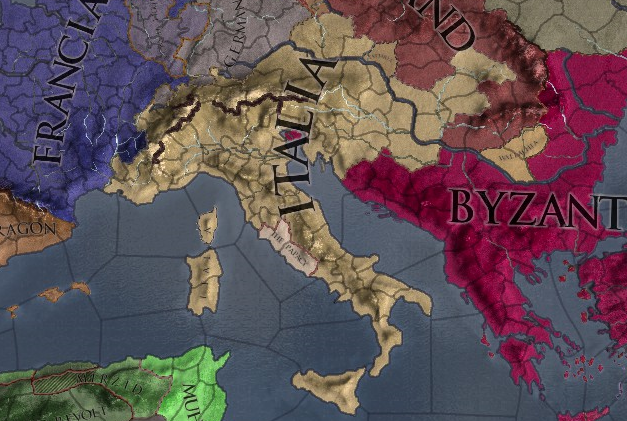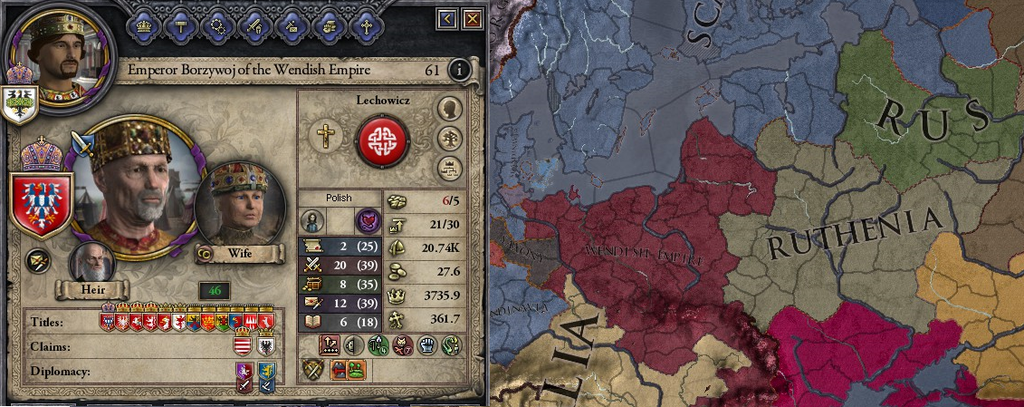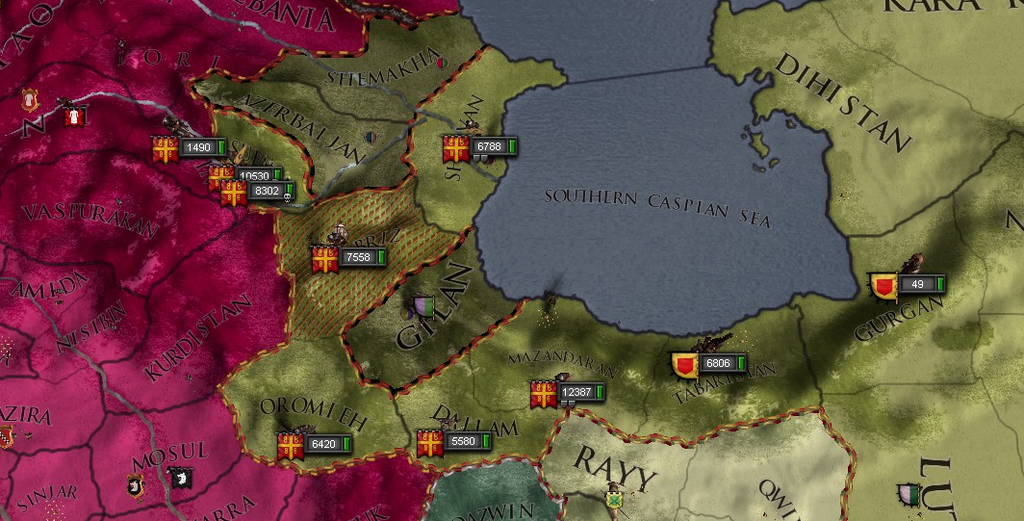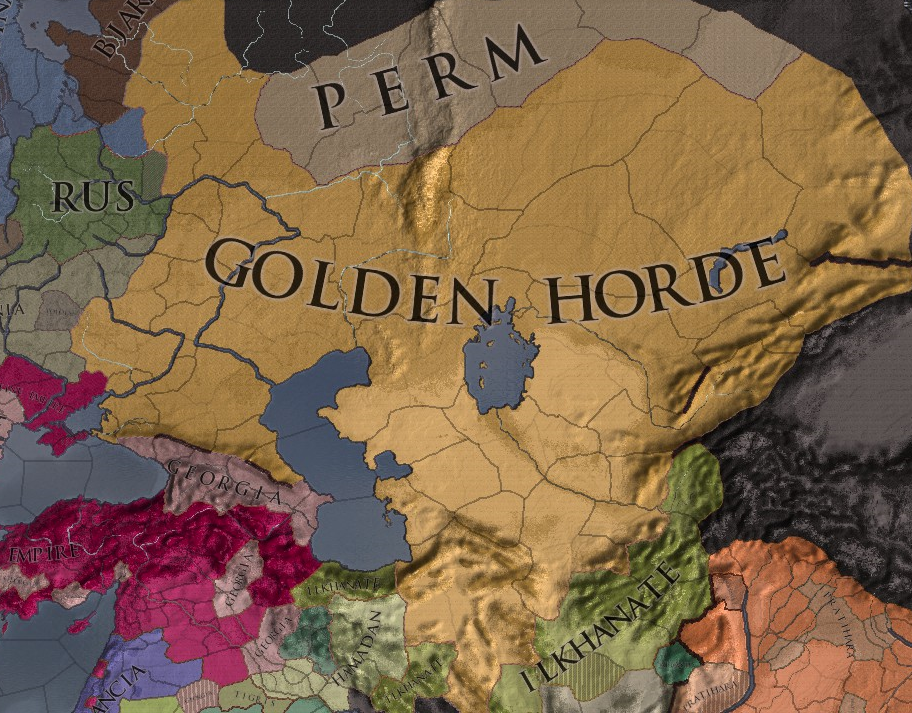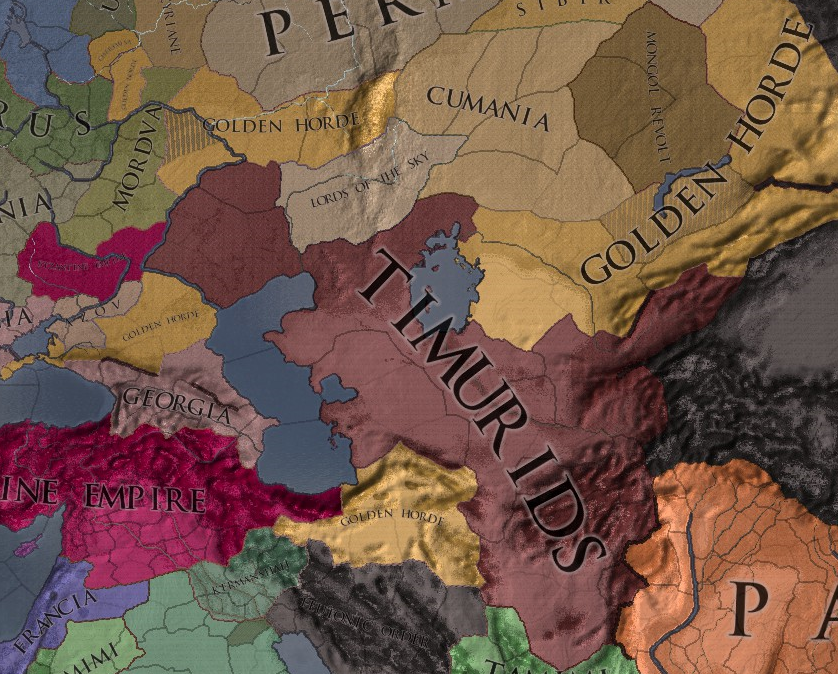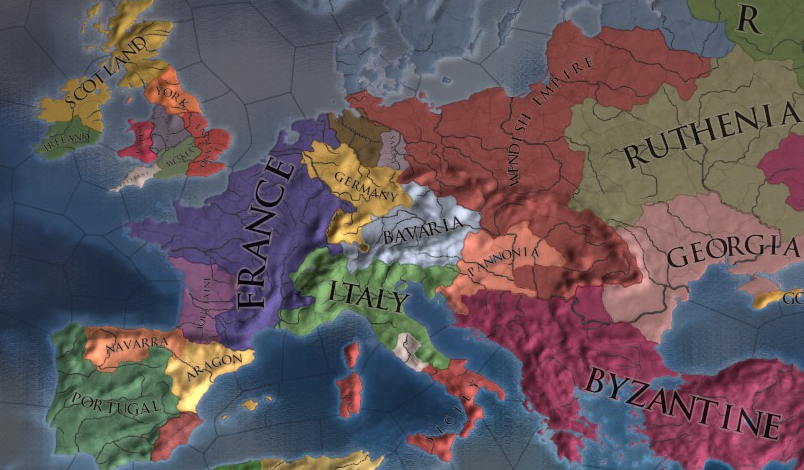A Brief History of Medieval Europe
769 - 1340 AD
The Karling Collapse and the Long-Lasting Lombards
When Karloman died in 771 AD (many believe he was assassinated), the Franks seemed poised to become the rulers of the most powerful kingdom in Europe. His brother Karl took control of all of Francia, and began his conquest eastward to incorporate Bavaria into his budding empire. But Karl fell ill and died just six years after inheriting his brother's kingdom, leaving a number of Frankish nobles to compete for the throne. Karl's son Hugbert held the kingdom together for one more generation, but his death in 828 shattered the Frankish mega-kingdom into eight separate realms, ending the hope of a unified Frankish kingdom for centuries.

Europe was now divided among France, Aquitaine, Burgundy, Middle Francia, Germany, Bavaria, Flanders, and Saxony, with each one maneuvering through wars an alliances in an attempt to claim supremacy. Over time, the Kings of House Leudoni would subjugate their rivals in western Europe to make France the sole stable power in the region, while Burgundy and Middle Francia were gradually whittled out of existence as France, Germany, and Lombardy picked them apart county by county to add to their own realms. And while the Frankish successor states scrambled to claim power, the kingdom of the Lombards on the Italian peninsula remained strong, keeping the realm peaceful and unified through an elective monarchy while they made slow progress at expanding northward.
The First Crusade and the Reconquista
By the turn of the tenth century, the conquests of the Sunni Muslim Sultans had spread through the Middle East, along the north African Coast, and into Europe, where almost the entire Iberian peninsula had fallen to the Umayyad dynasty. While the Franks were generally successful at stifling further attempts at invasions into Europe, no one had yet proven to be capable of driving the Andalusian Sultans back. Pope Vitalian II set out to change that in 900 AD, calling the First Crusade and sending the soldiers of Christian Europe on a mission to liberate the Kingdom of Aragon from the Umayyads.
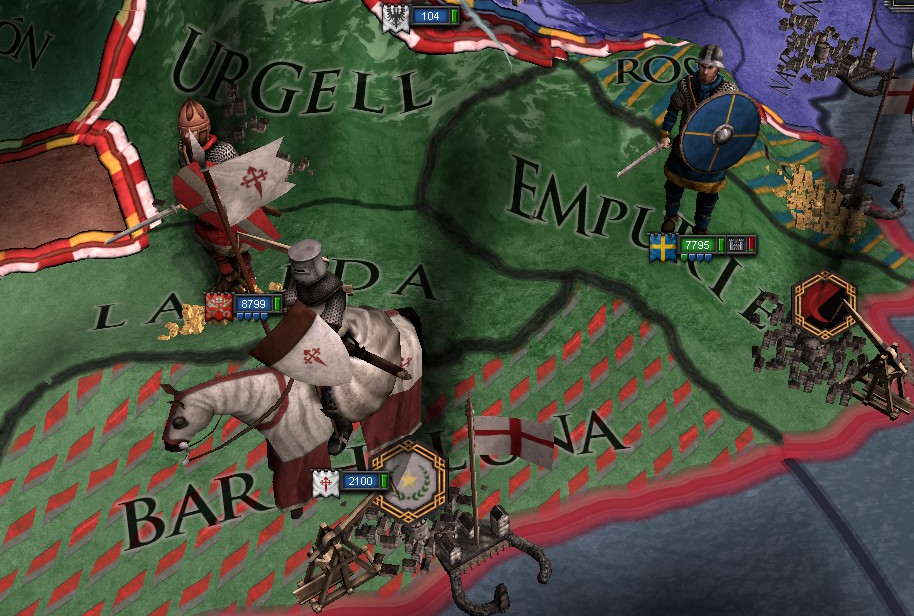
The First Crusade saw the rise to prominence of the Bavarae family, who would later rule as Kings of Lombardy and Emperors of Italy. The Bavaraes were then ruling in the Duchy of Friuli, Duke Arnifrid II expended substantial monetary resources to fund the Teutonic Order in support of the Crusade. Together with the various newly-formed holy orders, the King of Aquitaine, and several minor nobles from the British Isles, the Catholic armies drove the Muslims out of Aragon, marking the first of what would become many substantial victories for Christian Iberia. The victory promised relief for the struggling micro-kingdom of Galicia, barely holding on to its final scraps of land in the far northwestern corner of the peninsula.
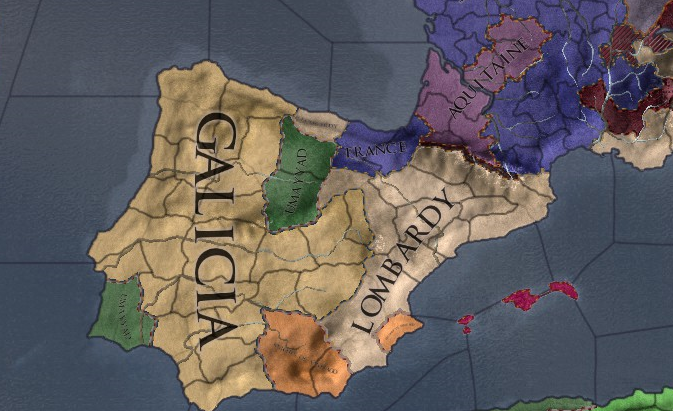
Galicia would grow exponentially throughout the ninth century. Supported by the Bavarae family, the Knights of Calatrava, and the Knights of Santiago, the kings of the de Cantabria dynasty waged a bloody Reconquista against the Umayyad Sultans, winning large stretches of territory in a series of exceptionally bloody holy wars. The Reconquista would be fully realized in 1003 AD, when the last Muslim counties in Iberia were occupied by the Galicians. Though they continued to mount new invasions well into the High and Late Middle Ages, the Umayyads never successfully conquered territory on the Iberian Peninsula after the conclusion of the Reconquista.
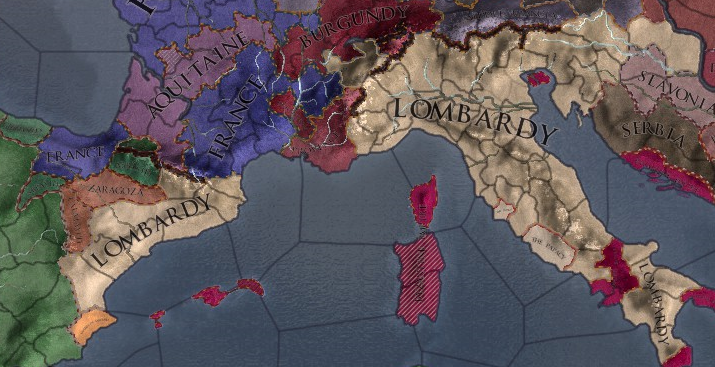
The First Crusade also proved a great boon for the Bavaraes and for Lombardy. In recognition of his great efforts in securing the success of the Crusade, Vitalian issued a Papal decree granting Arnifrid the right to rule the liberated duchies, while the kingship of Aragon was awarded to the kings of Lombardy, so that both crowns were joined under Lombard rule. With such a vast expanse of new land, Lombardy gained substantial additional wealth and manpower, strengthening its ability to exert influence in Iberia and continue to fight its bitter struggle against the Byzantine Empire, always waiting for an opportunity to claim more of Italy for the Greeks.
The Tengri Reformation and the Conquest of Jerusalem
While the Catholics were turning their armed might against the Muslims in Iberia, in the far east of the known world, another religion took its first major step onto the world stage. In 923 AD, not long after the Khazars established the Empire of Tartaria, the Tengri religion underwent a reformation process under the guidance of Khagan Kundaciq Ashina. With the establishment of a High Priesthood and the founding of an order of holy warriors known as the Lords of the Sky, Tengriism rose up to challenge the great Christian and Islamic faiths.
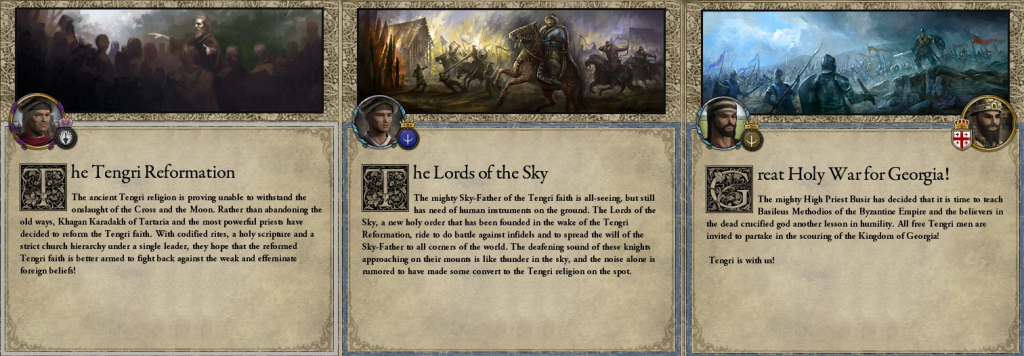
Invigorated by a new empire and a new church, the Tartars stormed southward and clashed with the powerful Byzantine Empire, capturing large portions of Georgia in a shockingly successful campaign. Unfortunately, the Great Holy War for Georgia would be the only successful campaign against Byzantium, and Tartaria would conquer little new territory until its eventual collapse during the Mongol invasions. Still, few local powers could effectively challenge Tartaria on its native land, and while little was gained, little was also lost for the next several centuries.
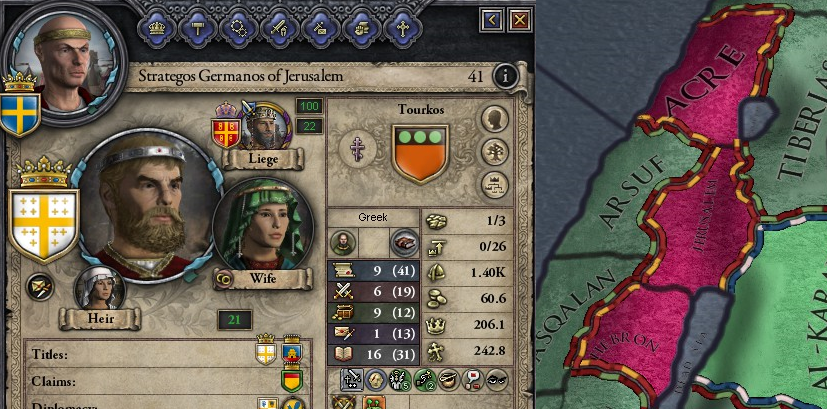
Unfortunately for Catholics, the century following the First Crusade saw the Church fall on hard times. The Lombards challenged Papal authority by establishing the "Lombard Papacy" based in Iberia, and as the unity of the Church faltered, Pope Sissinius III failed to gather the necessary support for the Second Crusade, and the planned invasion of Jerusalem failed miserably. Worse yet, in the face of the Pope's failure to claim the great holy city, the Byzantine Empire stepped in instead, occupying Jerusalem and establishing an Orthodox Patriarchate seated at the Church of the Holy Sepulchre. Sissinius' successor, Evaristus II, would later call the Third Crusade in another attempt to invade Jerusalem, but he would fail as his predecessor had.
The Division of Lombardy and the Fourth Crusade
When Aragon was conquered during the First Crusade, its land was placed under the authority of the Kingdom of Lombardy, and the two regions were ruled jointly by the Lombard king for most of the tenth century. But just before the turn of the 11th, the kingdoms were split when the popular opinions of the electors differed.
The noble families of Lombardy were split between three major candidates, but the majority elected Agilof II Bavarae to succeed to the throne in the homeland. The newly-landed families in Aragon, however, supported Saxo II Maiongi, son of the previous king, and elected him. After the election, the Bavaraes eventualy succeeded in dissolving the electoral process in favor of hereditary succession, cementing their place as the permanent rulers of Lombardy. The Maiongi line, on the other hand, lasted only a century in Aragon before the throne was usurped by King Bernard I, a Bavarae of a different branch than the one ruling in Lombardy.
At the end of the tenth century, the French and the Lombards helped lead the charge to depose the Aragonese Clement III, the last of the Lombard Popes, restoring the unity of the Catholic Church under the rightful Roman Pontiff. The restoration of a single, unified Papacy did much for Catholic morale, and the Fourth Crusade received widespread support when it was called to make a third attempt at seizing Jerusalem.
Finally, with many of Europe's largest kingdoms taking part, the Crusaders were able to drive the defending Muslim armies back and secure a foothold in the Middle East. While the Byzantine Army locked down the Holy City to prevent either side from entering, the Crusaders claimed the rest of the Kingdom of Jerusalem, which was awarded to France when victory was declared after a thirteen-year campaign in 1046 AD. The region remained divided between Catholics and Orthodox for the better part of two centuries, not to be reunified until the French occupation of the city in 1263.
The Imperial Age and the Twenty Years' War
After the violence and instability of the 11th century, the 12th saw a turn toward the consolidation of European power, as three different empires were proclaimed and established during the 1100's.
First, in November of 1152, Sten af Munso managed to unify Sweden, Finland, and Denmark, putting an end to a long series of succession conflicts due to the Gavelkind laws common in the region at the time. Under his direction, a single Catholic empire brought all three kingdoms into union, presenting a unified front against the numerically and technologically superior lords of Europe.
Less than a year later in the summer of 1153, Adalbert d'Oloron -- whose family had finally succeeded in replacing the long-ruling House de Chaumontois in France -- proclaimed the French Empire, only to be assassinated by a rogue officer from the Knights Templar a few months after his coronation as emperor.
The world stage was now becoming crowded with empires, but the Lombards were preparing to challenge one in direct combat. The Byzantine Empire had long been the Lombards' greatest rivals, controlling Sicily and several regions of southern Italy and frequently invading seeking more land. The struggle between the two realms was often a violent and bloody one, and many rulers and heirs were slain in battle, executed in dungeons, castrated, or viciously wounded during their many conflicts.
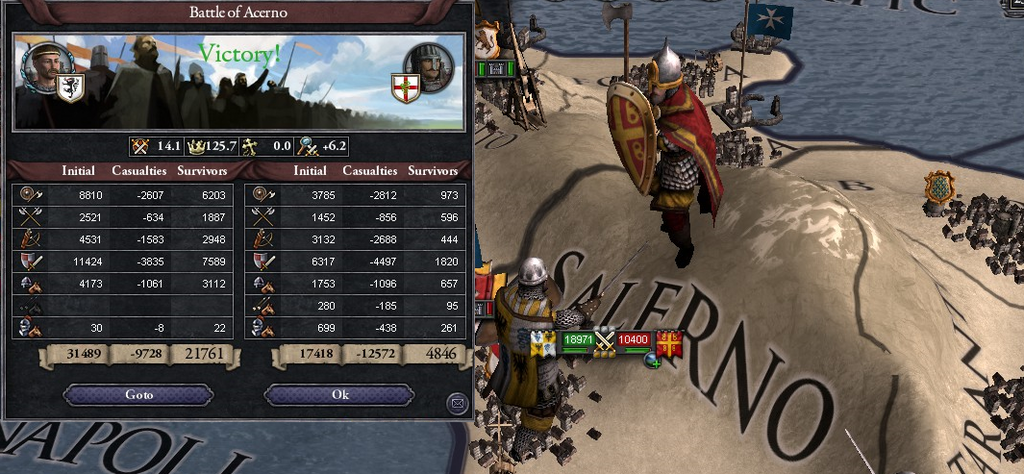
In the middle years of the 12th century, King Liutprand III of Lombardy waged an 18-year campaign which historians later dubbed the "Twenty Years' War," with the goal of finally expelling the Byzantine Empire from the Italian peninsula entirely. Emperor Basileios the Bold committed the full military might of Eastern Rome to the battle, and the peninsula was engulfed in a series of battles, some of the largest ever fought in the Lombard homeland. Casualties ran up by the tens of thousands as the Byzantine army struck by land and sea to subdue the unruly Liutprand.

But Liutprand proved a shrewd commander and secured multiple alliances to help ensure his victory. In the end, Basileios found southern Italy and Sicily overrun by the combined armies of Lombardy, Aragon, France, and Galicia, who together presented a force so overwhelming that not even the great Imperial Army could overcome it. Basileios surrendered in 1166 AD, returning all of Italy except for Venice, which would be conquered years later, to Liutprand.
New Empires and the Mongol Hordes
Liutprand's historic victory in the Twenty Years' War united the Italian peninsula under Lombard rule. By now, Lombardy was a sprawling kingdom spilling out into French, Slavic, and Germanic lands. In 1166, mere months after the conclusion of the Twenty Years' War, he claimed the title of emperor for himself, declaring the formation of the Italian Empire.
Italy was to be divided into four kingdoms. Lombardy, as the ancestral homeland of the family and the core of the empire, was ruled over by the emperor himself. Sicily, Bavaria, and Pannonia were given over to Viceroy Kings, who would rule over their respective realms until death, at which point the emperor could freely grant it to a successor of his choosing. While the various viceroyalties were not always at peace with one another or with the imperial crown, the system helped to decentralize the empire and allow for enough local autonomy to allow for the smooth execution of the emperor's will.
Christian Europe was quickly becoming crowded with emperors, but one more was still to come after Liutprand.
In August of 1249, ruling over Poland, Lithuania, Pomerania, and Bohemia, Borzywoj Lechowicz founded the Wendish Empire, seeking to establish himself as a powerful adversary to the growing kingdoms of Rus and Ruthenia in eastern Europe. Like the Scandinavians, the Wends were rarely known to conquer great portions of land, but they were able to form a strong defense against those who would exercise territorial ambitions against them.
The greatest territorial ambitions of the 13th century, however, were to be had by the Mongol invaders who swept down from the Steppes to bring chaos and terror to anyone in their path. When Hulegu Toluid led the Ilkhanate into Europe, he conquered large portions of land Tartaria and the Nardids, establishing a strong base before turning against his greatest obstacle -- the Byzantine Empire.
What followed was one of the worst defeats in the history of the Byzantine Empire. The Byzantines had stood relatively unopposed since the fall of the Western Empire, and the Twenty Years' War was their first substantial defeat in the Medieval era. But when faced with the Ilkhanate from the east and the Italian Empire from the west, the Byzantines folded on both sides. Italy recaptured the Slavic county of Veglia, and the Ilkhanate occupied a long stretch of native Persian land.
It was the greatest of the Ilkhanate's victories, but it was also its last victory.
The Byzantine Empire ruled over the world's largest land empire, and had a massive population from which to draw soldiers. Despite the deadly skill of the Mongol warriors, they lacked the sheer numbers to stand against Byzantium in a long campaign. When the Imperial Army came to reclaim what the Mongols had taken, the Ilkhanate could not match the manpower of their foes, and the Byzantines broke what remained of the once-feared army of horse archers.
The loss spelled the beginning of the end for the Ilkhanate, as the majority of their remaining land would soon be conquered by the Golden Horde, who came close to creating a unified European Mongol empire. The Khans of the Golden Horde would have brought all of the Steppe kingdoms under their control, were it not for the emergence of Timur Timurid.
The Timurids ravaged the southern portion of the Golden Horde's land, absorbing several small kingdoms that had revolted against the Horde or the Ilkhanate, driving a wedge through the Horde and splitting its territory in three.
The English Succession War of 1336
Historical consensus places the end of the High Middle Ages around the time of the English Succession War of 1336, an exceedingly brutal and costly war between the Iceling, de Chaumontois, and d'Oloron dynasties for control of the Kingdom of England. Prior to the war, the emperor of France had married Queen Sigrid Iceling, who inherited the throne after the death of the previously eligible heir. Because she had married in the French emperor's line, England was poised to be inherited by Prince Andre of France, in a succession that would have joined the mighty French Empire to the prosperous Kingdom of England.
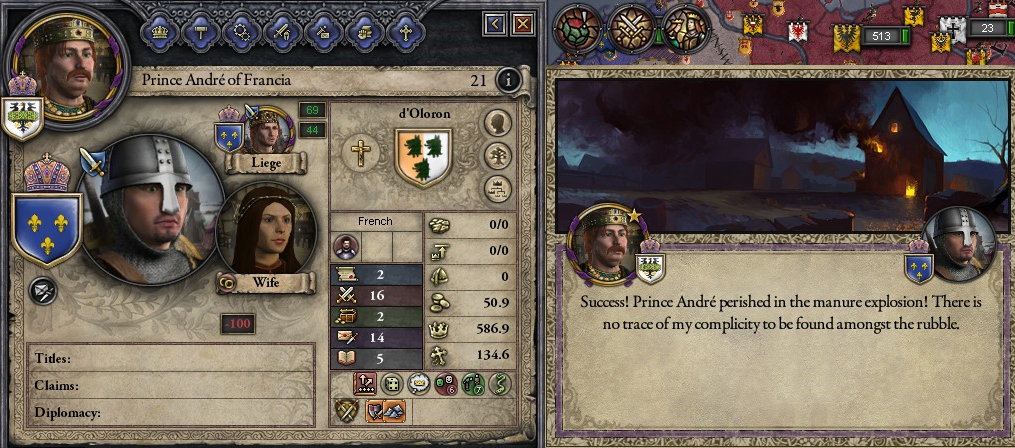
Recognizing that the joining of the two crowns would be a threat to the stability of Europe, Emperor Leopert IV of Italy arranged for the assassination of Prince Andre when the heir was only 21. The French crown passed on within the existing d'Oloron family, in accordance with French law. But due to England's different succession laws, the kingdom was inherited by Queen Sigrid's grandson through her eldest daughter: Menasses de Chaumontois, of the very family which the d'Olorons had ousted from power to take control of France. When Emperor Helie d'Oloron inherited the empire in 1336, he declared war on England to place his sister Elisabeth on the throne, taking by force what his family could not take by inheritance. In response, Empress Albina of Italy pressed her own war against England, seeking to place a son of the Iceling dynasty back in power.
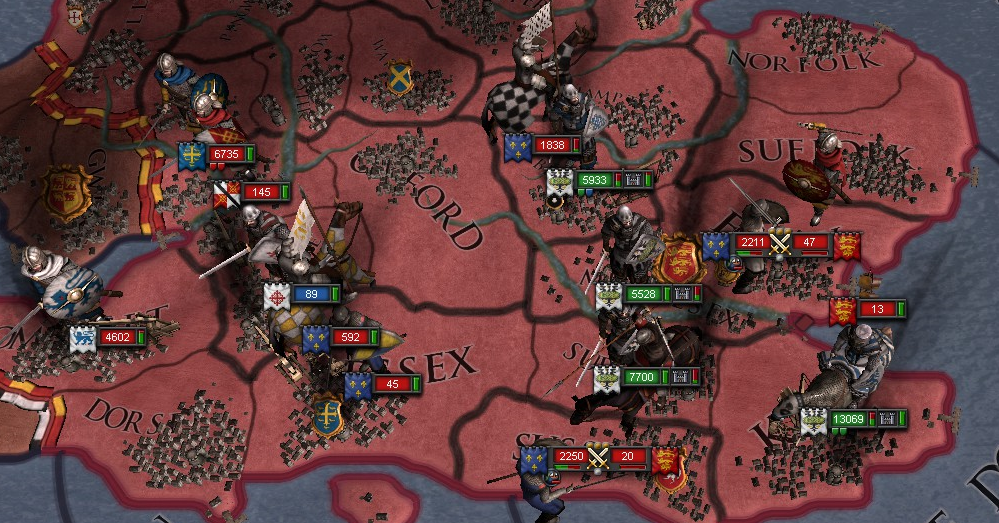
The fighting in southern England was widespread and vicious. French and Italian ships filled the waters around England, crowding her ports and releasing tens of thousands of soldiers onto her shores. Both France and Italy strained their populations with heavy taxes and mass conscriptions, sending multiple waves of reinforcements drawn from the young and old as the standing professional soldiers fell in battle. France was eventually defeated, but the English made such a strong resurgence that Italy, low on soldiers and dangerously close to bankruptcy, was forced to surrender not long after France.
The war succeeded in preventing France from incorporating England into the empire, but it failed to remove the French House de Chaumontois from power, leaving England in the rule of an ambitious foreigner at a difficult juncture in its history. The aftermath of the war would do much to shape the future of England, France, and Italy alike, and its repercussions helped to define the closing years of the High Middle Ages and set the stage for the Late Middle Ages and the transition into the Early Modern Period.
